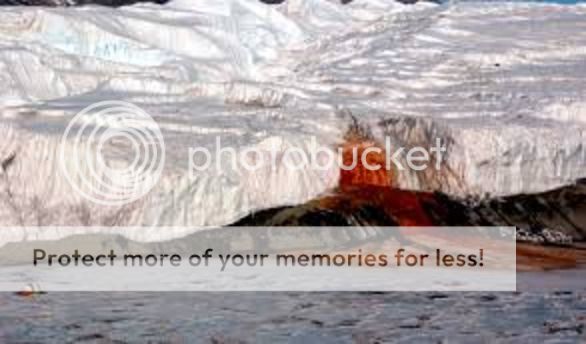-
*Astrella.
User deleted
Antarctica's Stunning Secret: the "Blood Falls"

It sounds like something out of a slasher movie: a waterfall that spouts blood. But the true nature of Antarctica's Blood Falls may be closer to sci-fi.
In the remote McMurdo Dry Valleys in Eastern Antarctica, a slow ooze of vivid crimson seeps from a fissure in the Taylor Glacier and onto the frozen surface of Lake Bonney. It’s easy to see where the five-story-high falls gets its name. The Earth itself seems to “bleed” out onto a landscape of pure white ice below in a stunning contrast.
According to EarthSky.org, Australian explorer Griffith Taylor discovered the strange falls in 1911 and originally, scientists thought that the color was the product of bright red algae in the water. But later studies revealed a far more amazing cause for the phenomenon.
Trapped deep under Taylor Glacier is a saltwater lake that is so cold, dark and oxygen-deprived that scientists originally thought it was uninhabitable. In a stunning find, a 2009 study by the National Science Foundation discovered that the extreme environment supports a unique and ancient population of microbes that are able to survive by converting iron and sulfur into energy. As the iron-rich water seeps out of a crack in the glacier, it rusts and stains the ice red.
The mystery doesn’t end there.
What’s more fascinating than the color of the falls are the microbes themselves, which are able to survive under conditions that almost no other life form on Earth can. According to ScienceNow, the fact that they’ve managed to adapt without sunlight or oxygen could have some serious implications for the possibility of finding life on other planets—like Mars or Jupiter’s frozen moon, Europa.
In a 2009 interview with ScienceNow, University of California, Santa Cruz glaciologist Slawek Tulaczyk suggests that the subglacial lake is as close to an “alien” environment as possible on Earth, and that the microbes provide a great basis for study of how life could adapt in space.
Not only do the presence of the microbes suggest a possibility for alien life, they also give some clue to life in other hostile environments on Earth—and how ancient life might have survived a proposed period of time called “Snowball Earth” or an extreme Ice Age.
But just how do these tiny-but-tough organisms survive where nothing else does?
ScienceNow reports that over a six-year period, geomicrobiologist Jill Mikucki collected and tested water samples and discovered 17 types of microorganisms that seemed to be able to “breathe” on ferric iron. Genetic analysis suggested that the microbes are similar to those found in the open ocean. And yet, the Dry Valleys (aside from Taylor Glacier) are much like a desert environment.
In fact, the microbe population was probably trapped in the subglacial lake when the floor of the Valleys rose—more than 1.5 million years ago! In some ways, the reservoir is like a natural time capsule, preserving a unique biological process in an organism resembling “primordial ooze.”
Whatever the case, Taylor Glacier’s subglacial lake and its unique inhabitants represent an environment not quite like anything else on earth.
Source: www.weather.com/news/stunning-secret-blood-falls-20130826.
Antarctica's Stunning Secret: the "Blood Falls"4 Gennaio 2014 |


